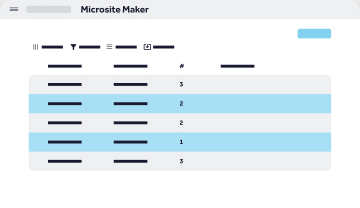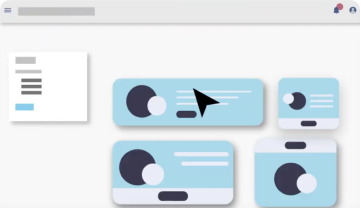Integrated marketing tools have become essential for enterprise teams struggling with content production bottlenecks. When marketing and sales teams work in disconnected systems, even simple customization requests can take hours or days. The right integrated marketing tools change this dynamic entirely, enabling self-service content creation while maintaining brand control.
If you’re spending your Tuesday mornings customizing sales presentations instead of developing strategy, you’re experiencing the cost of fragmented marketing technology firsthand. Here’s how integrated marketing tools solve this problem and what to look for when evaluating solutions.
The Content Production Bottleneck: Why Marketing Teams Need Integrated Tools
Enterprise marketing teams face a predictable challenge: endless customization requests from sales. Someone needs a presentation tailored for a prospect meeting. Another person needs an industry-specific one-pager. A third needs a microsite customized for a vertical market.
Each request is reasonable and important. But when your marketing tools aren’t integrated, every customization requires manual work from someone with design skills, brand knowledge, and file access.
This creates the classic bottleneck. Sales needs materials fast. Marketing wants to help but has a queue of requests. Work gets rushed, stakeholders wait longer than they should, or both happen simultaneously.
The real issue is that most of this work isn’t exactly creative or strategic. You’re not developing breakthrough campaigns – you’re updating slide 7 with a new logo. You’re swapping industry examples in a deck you’ve customized dozens of times. You’re doing repetitive work that shouldn’t require an expert.
In fact, 84% of sales executives identify content search and utilization as the biggest area for productivity improvement. The problem is clear: your marketing technology stack requires specialists for tasks that should be self-service. Even worse, underused or unused marketing content costs enterprises approximately $2.3 million annually in missed opportunities.
What Are Integrated Marketing Tools? Understanding True Integration
When people discuss integrated marketing tools, they often mean software that connects to other platforms – your CRM syncing with your email system, or your analytics dashboard pulling from multiple sources. That’s useful, but it’s not what solves the content production problem.
True integrated marketing tools connect people to the content they need, when they need it, without requiring specialist intervention every time.
Think about your current state: brand guidelines exist, approved messaging exists, templates and assets exist. But they live in different places, require different skills to access, and lack guardrails to prevent mistakes.
Integrated marketing software consolidates all approved content – presentations, collateral templates, messaging frameworks, brand assets – into a centralized system where teams can access and customize materials themselves, safely.
The critical word is “safely.” This isn’t about giving everyone Photoshop access and hoping for the best. Effective integrated marketing tools build brand rules directly into the system, allowing customization only within approved parameters while ensuring everything stays on-brand and on-message.
How Integrated Marketing Software Transforms Team Workflows
When you implement integrated marketing tools, three fundamental shifts occur:
Marketing’s Role Evolves from Execution to Enablement
Instead of spending hours making small customizations, marketing teams focus on building systems that enable self-service. You create templates once, define customization parameters, and establish guardrails. Then you move to strategic work – developing campaigns, crafting messaging, building brand value.
This doesn’t eliminate marketing’s role; it elevates it. You remain the brand steward and strategic voice. You’re just not spending three hours updating a deck that sales could customize in ten minutes with the right integrated marketing tools.
Sales Gains Necessary Autonomy
Sales teams don’t want to wait for marketing to update materials. They want to walk into meetings with content that speaks directly to their prospects. Integrated marketing software makes this possible.
With proper marketing automation and integration, sales opens a template, customizes relevant sections, and gets exactly what they need – without waiting, without going off-brand, without needing design expertise.
This self-service capability transforms responsiveness. Sales teams can personalize materials for opportunities in real time rather than planning days ahead for content requests. Marketing maintains confidence that everything representing the brand meets standards.
Unexpected Benefits of Integration Emerge
Beyond time savings, integrated marketing tools reveal patterns and insights that weren’t visible before.
When teams work from centralized content libraries, collaboration improves. The New York office sees what London created and adapts it. Sales leaders identify which materials drive results and which go unused. Marketing spots patterns in customization requests that reveal new content needs.
The visibility that integrated marketing software provides is valuable intelligence. You see what’s being created, how it’s used, and where real demand exists. And the business impact is significant: research shows that companies with consistent branding across all platforms can increase revenue by up to 23%, making integrated marketing tools not just a time-saver but a revenue driver.
Essential Features of Effective Integrated Marketing Tools
Not all marketing technology that claims integration delivers on the promise. Here’s what matters:
Intuitive Customization Capabilities
If your integrated marketing tools require extensive training or design skills, you haven’t solved the problem – you’ve relocated it. The best marketing automation and integration platforms let users customize presentations and collateral in minutes through drag-and-drop interfaces.
Built-In Brand Governance
Your integrated marketing software should make going off-brand impossible, not just unlikely. Fonts, colors, logos, approved messaging – all of this gets locked into template structures. Users customize content without the ability to break brand standards.
Multi-Format Content Support
Teams need more than presentations. Effective integrated marketing tools handle one-pagers, fliers, microsites, proposals, and multiple content types within a single platform.
Centralized Content Management
Everything approved should live in one searchable library with version control. When someone needs a template, they shouldn’t hunt through shared drives or email threads for current versions.
Analytics and Usage Insights
The best integrated marketing software shows what’s being created and used. This data informs content strategy and helps you understand what actually drives results.
Marketing Technology Stack Integration
Consider how integrated marketing tools connect with your existing CRM, marketing automation platform, and other systems. Seamless data flow between platforms maximizes the value of integration.
Implementing Integrated Marketing Tools: A Practical Approach
Deploying integrated marketing software doesn’t require complexity, but it does need intentional planning.
Start with Your Biggest Pain Point
For most enterprise teams, that’s sales presentations. They’re requested constantly, need frequent customization, and directly impact revenue. Get presentation templates into your integrated marketing tools first, prove value, then expand to other content types.
Build Your Content Library Strategically
Invest time upfront to save it later. Create genuinely flexible templates that customize for different industries, company sizes, use cases, and sales stages. Define what can change and what can’t. Develop clear, reusable content modules that mix and match.
Plan for Adoption
The best integrated marketing tools don’t help if people don’t use them. Ensure your sales team understands what’s available and how it makes their work easier. Celebrate early wins. Share examples of effective customizations. Create internal advocates who help others get started.
Measure What Matters
Track time saved – it’s meaningful. But also monitor request volume, turnaround times, team satisfaction, and content usage. The goal of integrated marketing software isn’t just efficiency; it’s enabling better collaboration and better work.
The Strategic Advantage of Integrated Marketing Tools
Integrated marketing tools don’t just accelerate content production. They fundamentally transform how marketing relates to the teams they support.
When marketing constantly executes customization requests, they’re perceived as a bottleneck – a necessary step that slows things down. When marketing enables self-service through integrated marketing software, they become strategic partners who empower the business to move faster.
This shift matters not because it saves time (though it does), but because it lets marketing teams focus on what they’re uniquely qualified to do: developing strategy, creating compelling campaigns, and building brand equity.
Taking the Next Step with Integrated Marketing Tools
The customization requests won’t stop. The question is whether you’ll spend your time executing them or building systems that let your organization serve itself while you focus on strategic work.
Start by mapping your current content workflow. Where are the bottlenecks? What gets requested repeatedly? What requires your intervention but shouldn’t? Those friction points represent your opportunity.
Evaluate integrated marketing tools based on how well they address your specific pain points. Look for platforms that offer genuine self-service capabilities, strong brand governance, intuitive interfaces, and comprehensive support for various content formats.
The right integrated marketing software doesn’t eliminate marketing’s role – it elevates it, transforming teams from order-takers into strategic enablers who drive real business value.
That’s what we’ve built here at Clatter. If you’d like to see our solution, just click here.




